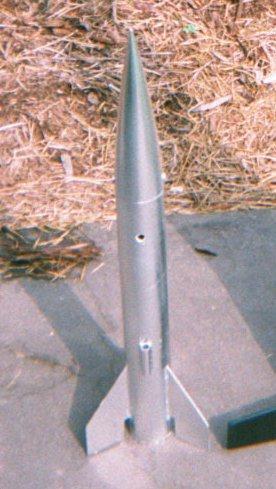Scratch One Shot Original Design / Scratch Built
Scratch - One Shot {Scratch}
Contributed by Dick Stafford
| Manufacturer: | Scratch |
 Brief:
Brief:
After losing my RocketVision Machbuster on a G55, I decided that I wanted to build a similar rocket that would fly on 29mm motors. I scrounged through my parts bin and, being a 'glass-half-full' type, named the result 'One Shot'.
Construction:
Parts List:
- 29mm phenolic tube, 9.25" (Giant Leap)
- 0.047" G-10 stock for the 3 fins (Giant leap)
- 1/8" aluminum tubing for launch lug
- one NC, BT-55 (Estes)
- one spent 29mm casing for nose cone shoulder and motor block.
- one eyebolt
- 5' of 1000 lb Kevlar cord (Pratt)
- 3/4" x 25' plastic tape (Home Depot)
- lead shot
I started with a leftover section of 29mm phenolic tubing. I decided to add a motor block so I cut a 1/2" section out of a spent 29mm casing with a razor saw. This was epoxied into the tube so that a G80 would protrude by 1/2". After playing around with Rocksim, I decided on a fin design that I found appealing. Since I wanted the fins to sit flush with the end of the rocket and I wanted to be able to wrap a layer of tape around the end of the rocket and the engine, the last 3/4" of the root edge of the fin was recessed by ~ 1/4" (see pic or Rocksim file).
Using a dremel cutting wheel, I slotted the tube so the fins would slip in. To install the fins, I inserted a 29mm casing, applied a small amount of epoxy to the slot, and pushed the fin in until it touched the motor casing. After all 3 fins were installed, the casing was removed. This was easily accomplished before the epoxy began to set. This method of through-the-wall construction really works well for small fins, especially with relatively thick tube (0.062"). The fins were straight and weren't going anywhere. When the epoxy dried, I applied fillets.
Since the NC that I had wouldn't fit in the body tube, I cut the shoulder-end off so it sat flush with the tube's OD. Another section of 29mm casing was cut to use as a shoulder. This fit snugly into the NC and was held in place with 2 small screws. I added nose weight (lead shot, epoxy and the eyebolt) so the rocket would be stable. Because the end of this little missile was now largely lead, I was conservative on setting the CG (see Rocksim file).
The recovery harness consisted of 5' of 1000 lb test Kevlar line. One end was epoxied into the body tube and the other was tied to the eyebolt. In the end, I built a rocket that was probably heavier than it had to be and had a non-optimal fin design. Oh well, won't be able to see the difference at ~5000ft anyway! I didn't bother filling the grooves in the tube since I wasn't optimistic about getting this rocket back. I did, however, give it a layer of Krylon chrome paint. Maybe a shiny surface would be easy to spot???
Flight:
Because of the predicted altitude and weight, this is not a rocket I would want to fly at a model rocket field, so I waited for a HPR launch. The streamer was a 25' section of 3/4" bright orange plastic tape. When rolled tightly, this fit nicely into the 29mm tube. Estes-type wadding was used to protect the streamer. I was torn between using a G125-15 and a G80-10FWL. The 15 sec delay on the G125 was about right and the 10 sec delay was too short. Anyway, I ended up using the G125 in another rocket and hoped the 1000 lb Kevlar® would hold up. Well, One Shot exploded off the pad and, like my Machbuster, was never seen or heard from again.
Summary:
PRO's 1. High performance rocket built from leftovers in the parts bin. CON's 1. Another non-recoverable rocket (when flown on big engines)
Other:
When surface mounting small fins on minimum diameter rockets, you can get added strength by slotting the tube and gluing the fins into the slots. An engine casing is inserted to keep the fin flush with the inside of the tube. You must make sure you work fast and don't glue the casing in. In my case I used epoxy and a phenolic motor casing (AT SU). The thicker the tube, the better this will work. (Idea 'borrowed' from the RocketVision Machbuster.)
 |
 |